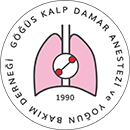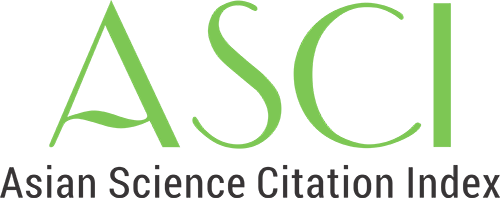

Volume: 19 Issue: 2 - 2013
| REVIEW | |
| 1. | Fluid and electrolyte therapy in cardiac surgery Fevzi Toraman doi: 10.5222/GKDAD.2013.053 Pages 53 - 66 (2117 accesses) Nowadays; it is well known that successful perioperative management of patients undergoing surgical procedures are upon a succesful fluid and electrolyte balance. Hence the evaluation and correction of blood, fluid and electrolyte disorders are of great importance for the surgical patients. Besides, as the reasons of these are not known in details some precautions in order to prevent patients going under surgical procedures from blood, fluid and electrolyte disorders should be considered. Fluids with different farmacocinetic and farmacodynamic properties are widely used for the therapy. Not only hemodynamic parameters but also microcirculation, pulmonary functions, erythrocyte rheology and coagulation cascades should be considered for fluid choice in cardiac surgery patients. To provide the ideal volume replacement therapy during cardiac surgery, the whole process shall be considered in three periods; before CPB, CPB period (priming volume) and after CPB and ICU period.The studies fort he cardiac surgery patiens concerning pre CPB period is limited and the results are incompatieble with each other. These studies are routing the clinicians for the choice of crystalloid or colloid and moreover for the choice of colloid type. Both cristalloids and colloids were shown to be superior to the other in these studies. For this reason, it is impossible to find a clear answer fort he type of fluid to be chosen for today. It can only be conceived that HES is not adviced in CPB as it increases bleeding after CPB. |
| EXPERIMENTAL WORK | |
| 2. | The Comparison of the Effects of the Off-Pump and Cardiopulmonary By-Pass Techniques Upon Postoperative Delirium at Elective Coronary By-Pass Greft Surgery Engin Yılmaz, Murat Aksun, Senem Girgin, Şeref Gülseren, Volkan Kuru, Atilla Şencan, Lale Koroğlu, Gülçin Aran, Nagihan Karahan doi: 10.5222/GKDAD.2013.067 Pages 67 - 75 (1402 accesses) OBJECTIVE: In our study, we aimed to compare the effects of cardiopulmonary technique and off-pump technique on the progress of delirium in elective coronary artery by-pass graft surgeries. METHODS: Between the ages of 20-80; 40 cases scheduled for cardiopulmonary by- pass (Group 1) and 30 cases for off-pump techniques (Group 2) were involved in our study. Patient anxiety and depression scale test and short cognitive examination scale were performed and the scores were recorded the day before the surgery. On postoperative 24 hours and 72 hours delirium grading scale (DGS) assessments were performed by the pschiatry clinic. RESULTS: There were no patients with delirium diagnosis according to DSM-IV criteria and none of the patients scored more than 12 points with DGS. Two groups were compared with their 24th and 72nd hour DGS results. In Group 1, 24th and 72nd hour- DGS scores showed a statistically significant correlation between the time of anesthesia and intensive care unit stay (p<0.05). However, in Group 2 there was a statistically significant correlation only between intensive care unit stay and 24th and 72nd hour-DGS scores (p<0.05). In Group 1, smoking and use of ß-blockers statistically increased the DGS scores on 72nd hour (p<0.05). In Group 2, use of statins statistically decreased the DGS scores on 72nd hour (p<0.05). Compared to Group 2, independent of anesthesia, and operative times, and necessity of transfusion, 24th hour- DGS scores were higher in Group 1. Compared to Group 2, independent of operative times, and necessity of transfusion, when anesthesia time was < 180 minutes 72nd hour- DGS scores were significantly higher in Group 1. CONCLUSION: We think that smoking, use of ß-blockers, duration of anesthesia and intensive care unit stay may be a risk for delirium, use of statins seem to decrease the risk. |
| 3. | The Effects of Metabolic Syndrome on- Pulmonary Complications in Patients Undergoing on- Pump Coronary Artery Bypass Grafting (CABG) Procedures Şebnem Banu Saraç, Tülay Kayacan Örki, Atakan Erkılınç, Halide Oğuş, Rezan Yatırık, Füsun Güzelmeriç, Tuncer Koçak doi: 10.5222/GKDAD.2013.076 Pages 76 - 79 (1237 accesses) OBJECTIVE: We evaluated the effects of metabolic syndrome on pulmonary complications in patients undergoing on- pump coronary artery bypass grafting (CABG) procedures. METHODS: 353 patients who underwent on-pump CABG were included in this study. The diagnosis of metabolic syndrome is made according to the criteria of the National Cholesterol Education Program Adult Treatment Panel III in 2001 organized in the United States of America (NCEP III, 2001). 245 patients had the diagnosis of metabolic syndrome.The patients were divided into two groups of with and without metabolic syndrome. Demographic data, operative variables, ICU (intensive care unit), and hospital stay and postoperative pulmonary complications were all recorded. RESULTS: Body mass indexes, fasting glucose, and triglyceride levels, arterial blood pressures and the rate of diabetes mellitus (DM) were relatively higher, but high- denslity lipoprotein (HDL) levels were lower in the metabolic syndrome group. Both groups showed comparable results with respect to cardiopulmonary bypass, aortic cross- clamping, and total operative times and the number of grafts used. However,in the metabolic syndrome group. CONCLUSION: As postoperative pulmonary complications of on-pump CABG, atelectasis and pnomonia are seen more often in the patients with metabolic syndrome. |
| RESEARCH ARTICLE | |
| 4. | The Effect of Beta-blocking Agents on Morbidity and Mortality Following Coronary Artery Bypass Surgery. Tülün Öztürk, Ahmet Asım Koçan, Funda Yıldırım, Damla Alp, Taner Kurdal doi: 10.5222/GKDAD.2013.080 Pages 80 - 85 (1389 accesses) OBJECTIVE: Aim of this study was to investigate the effect of beta-blocking agents on both short and long-term morbidity and mortality in patients undergoing coronary artery bypass surgery. METHODS: Between January 2010 and March 2012, the patients undergoing coronary artery bypass surgery in our cardiovascular surgery clinic were divided into two groups; Group B included patients that had been using beta-blocking agents preoperatively, and Group C patients consisted of patients that were not on beta-blocking agents. Demographic and clinical characteristics, both intraoperative and postoperative clinical parameters as well as short (30-days) and long term (1 year) rates of morbidity and mortality were retrospectively evaluated. RESULTS: Number of patients with atrial fibrillation was significantly lower in Group B (n=17, 20% vs. n=28, 35%; p<0.01). Frequency of agitation-delirium in Group B was also significantly less than Group C (n=2, 3% vs. n=8, 10%; p=0.05). Thirty-day morbidity was also higher in Group C than Group B (n=28, 35% vs. n=17, 20%; p<0.04), however this difference disappeared over 1 year (n=30 38% vs. n=24, 28%; p=0.2). Mortality rates of neither 30-day nor 1 year were statistically significant between the groups B and C (p=0.4 and p=0.2, respectively). CONCLUSION: Compared to control group, the frequencies of both atrial fibrillation and agitation-delirium were significantly lower in Group B in this cohort of patients. The long term use of beta-blocking agents prior to coronary artery bypass surgery appears to markedly reduce 30-day morbidity despite this effect was not reflected to short and long term mortality rates. |
| EXPERIMENTAL WORK | |
| 5. | Is Remifentanil Superior to Nitrous Oxide Regarding the Clinical Effects? Elzem Şen, Ayşe Mızrak, Sıtkı Göksu doi: 10.5222/GKDAD.2013.086 Pages 86 - 91 (1523 accesses) OBJECTIVE: We aimed to compare the effects of N2O and remifentanil on hemodynamic parameters, B12 vitamin values, recovery times, side effects, patient and surgeon satisfactions. METHODS: Seventy-five ASA I-II women scheduled for abdominal hysterectomy were randomly divided into three groups as nitrous oxide (Group N), remifentanil (Group R) and control (Group K) groups. In each group, the patients were given 2 mg kg-1 propofol, 0.6 mg kg-1 rocuronium during induction of anesthesia. In the remifentanil group following 0.5 μg kg-1 bolus remifentanil, 0.2 μg kg-1 dk-1 infusion was started. Following endotracheal intubation, fresh gas 4 L dk-1 containing 50 % O2/N2O (in Group N) or medical air (in Group R, K) in with 2 % sevoflurane was given. Hemodynamic parameters, B12 vitamin, side effects, patient and surgeon satisfactions and recovery times were recorded. RESULTS: In the remifentanil group, intraoperative heart rate (HR) values were found statistically significantly lower than those of the control group at 0., 10., 15., 30. minutes (p<0.05). In Group N, HR values were statistically significant higher than Group R at intraoperative 5., 30., minutes and postoperative 0. minute (p<0.05). In group N, the intraoperative mean arterial pressure (MAP) at 45. minute was statistically higher than group R (p=0.02). Aldrete Recovery Score to be 9 in Group N was statistically significantlt longer than Group R (p=0.009). Surgeon satisfaction levels in groups were in decreasing order as Group R > Group N > Group K (p<0.05). In Group N, nausea and vomiting were statistically significantly higher than Group R (p=0.001). CONCLUSION: Although remifentanil provided more rapid recovery with less frequent postoperative nausea, and when compared with nitrous oxide, both of them provided a stable hemodynamic effect and a satisfactory general anesthesia. |
| RESEARCH ARTICLE | |
| 6. | The Importance Of Learning Effect In The Assessment Of The Reversibility Measurement By Pulmonary Function Test Selvi Aşker, Esra Eker, Müntecep Aşker doi: 10.5222/GKDAD.2013.092 Pages 92 - 94 (1412 accesses) OBJECTIVE: The reversibility measurement by pulmonary function test (PFT), used in diagnosing, staging and following up of asthma and COPD, may cause misleading results in its first application. Herein similar procedures were repeated one after another that one would get familiar with the test in the first application and could perform better in the second, causing the physician to misinterpret the result of the reversibility test, by causing the difference between two test results. Aim to investigate whether the learning effect in the first application of PFT leads to false reversibility. METHODS: 43 patients suggested to have bronchial hyperreactivity or asthma performed PFT and then shortly after the previous one the test was repeated without bronchodilator intervention. FEV1 values of two tests were compared. Third FEV1 was measured 30 minutes after. Paired T test was used as statistical, to determine the difference between the measurements. RESULTS: FEV1 variability was determined as % 6±2.3 between 1st and 2nd test results (p<0, 01). FEV1 variability between 2nd and 3rd test results was found as % 1±2.2 (p>0,05). PEF variability was determined as % 5,2 between 1st and 2nd test results (p<0, 05). PEF variability between 2nd and 3rd test results was found as % 2,5 (p>0,05) CONCLUSION: Study showed the presence of learning effect on the measurements of reversibility. The presence of difference between 1st and 2nd test results showed learning effect. Similarity between the 2nd and 3 rd test results also supported the learning effect. In cases suggested to have bronchial hyperreactivity or asthma, at least two basal FEV1 measurement should be performed and necessary to give bronchodilator agent after the 2nd test; and not necessary to have 3 rd test for basal FEV1 measurement. |
| CASE REPORT | |
| 7. | The Anesthetic Management of a Patient with Marfan Syndrome and Renal Transplant Patient Undergoing Bentall Operation Yücel Karaman, Aylin İncesu, Burçin Abud, Hüseyin Özkarakaş, Cengiz Özbek doi: 10.5222/GKDAD.2013.095 Pages 95 - 99 (1534 accesses) Marfan syndrome (MFS) is a genetic disorder with the high mortality rate when causes aortic aneurysm and aortic insufficiency. Bentall procedure is an aortic root and valve surgery, can maintain near-normal life time in MFS patients, however prolonged extracorporeal circulation and crossclamp times is the drawback of the procedure. In this case report, we discussed the anesthesia management of a patient with MFS and history of renal transplantation undergoing Bentall procedure. |
| 8. | Bidireksiyonel Kavapulmoner Şantlı Çocukta Spinal Anestezi ile Sünnet Ameliyatı Esra Çalışkan, Mesut Şener, Hatice İzmirli, Aysu Koçum, Anış Arıboğan doi: 10.5222/GKDAD.2013.100 Pages 100 - 102 (1499 accesses) The bidirectional cavapulmonary shunt (BCPS) is performed for various cyanotic congenital heart defects, mainly those involving an eventual singe-ventricle repair (1). This shunt consisted of an anastomosis between the divided end of the superior vena cava to the side of the undivided right pulmonary artery. In patients with bidirectional superior cavapulmonary shunt anything causing high intrathoracic pressure such as coughing, intubation, postoperative agitation with increased mean airway pressure or breath holding will cause a significant reduction of pulmonary blood flow (PBF), and therefore significant desaturation. In BCPS patients who performed general anesthesia, spontaneous breathing with smooth and early extubation is a safe procedure to maintain systemic oxygen levels in these patients. In this reason spinal anesthesia can alternative technique to general anesthesia with adequate airway control without entubation. In this case report, we represented a 6 year-old boy was performed spinal anesthesia for circumcision operation. Key words: Spinal anesthesia, pediatric surgery, bidirectional superior cavapulmonary anastomosis |
| 9. | Complication of Right Subclavian Vein Catheterization: Superior Vena Cava Perforation Burçin Çelik, Serhat Kocamanoğlu, Yasemin Bilgin Büyükkarabacak, Esra Sarıhasan doi: 10.5222/GKDAD.2013.103 Pages 103 - 105 (1794 accesses) Central venous catheterization is an invasive approach which is routinely used in thoracic surgery operations. Pneumothorax and hemothorax are among the most frequent complications. Vena cava superior (VCS) perforation (0.5%) is very rarely observed. The 65-year-old male patient admitted to the hospital with the complaint of cough. With the examinations performed, he was diagnosed with epidermoid lung cancer located in the right lower lobe of the lung. To prepare the patient for the operation, endotracheal intubation and right subclavian vein catheterization were performed by the anesthesia team. During exploration, it was found that central catheter placed into the right subclavian vein perforated the vein and after proceeding a little in the intrathoracic space, entered the vena cava superior in front of the phrenic nerve. The catheter was withdrawn and vena cava superior was repaired with 5/0 prolene suture. The patient developed no post operative problems, thus he was discharged with full recovery following right lower bilobectomy. |
| 10. | Red Man Syndrome Nazan Atalan, Osman Fazlıoğulları, Serdar Akgün doi: 10.5222/GKDAD.2013.106 Pages 106 - 108 (3634 accesses) Vancomycin is one of the glycopeptide antibiotics which is used against Gram (+) bacterial infections especially caused by Methicillin Resistant Staphylococcus Aureus (MRSA). In this case report, we want to present a patient in whom Red Man Syndrome (RMS) was developed due to vancomycin treatment for the mediastinitis following coronary arterial bypass surgery (CABG). A 56 year- old patient who had CABG developed MRSA mediastinitis. Based on the results of the antibiotic susceptibility tests, intravenous vancomycin (1g bid) treatment was started. At 5th day of the treatment disseminated and partly intermingled, itchy and erytematous rushes especially at the upper part of the body and hypotension were developed. Following dermatological evaluation, diagnosis of RMS was established. RMS usually happens as a result of rapid infusion of vancomycin. In these circumstances. Teicoplanin and Linezolid should be thought as alternative treatment regimens. |

















